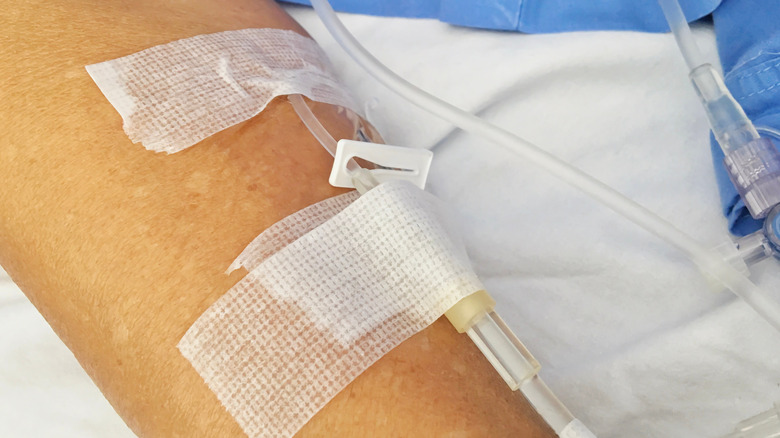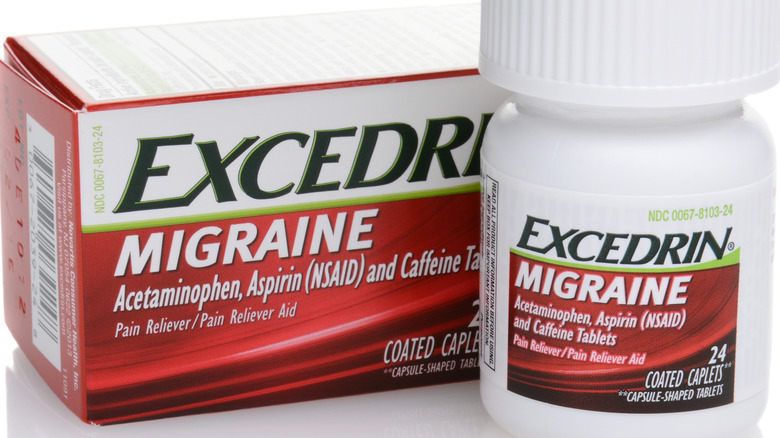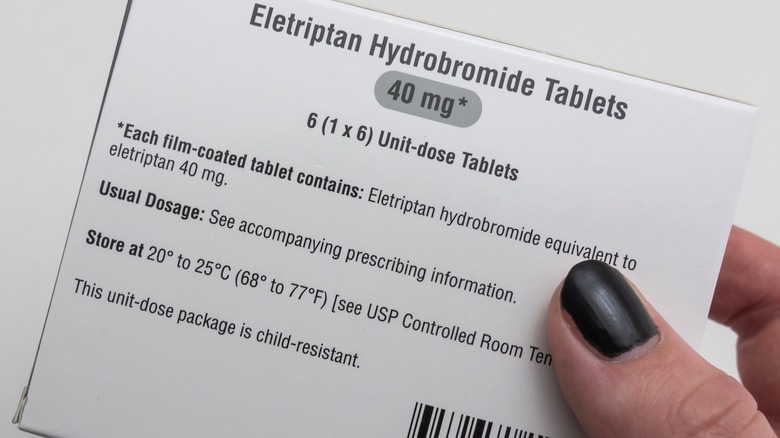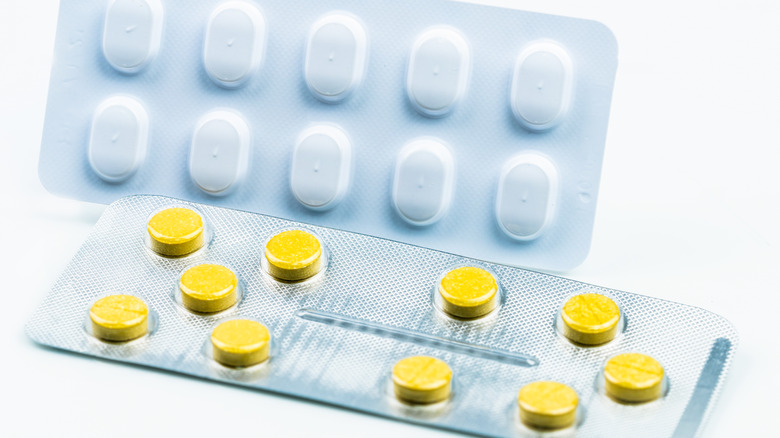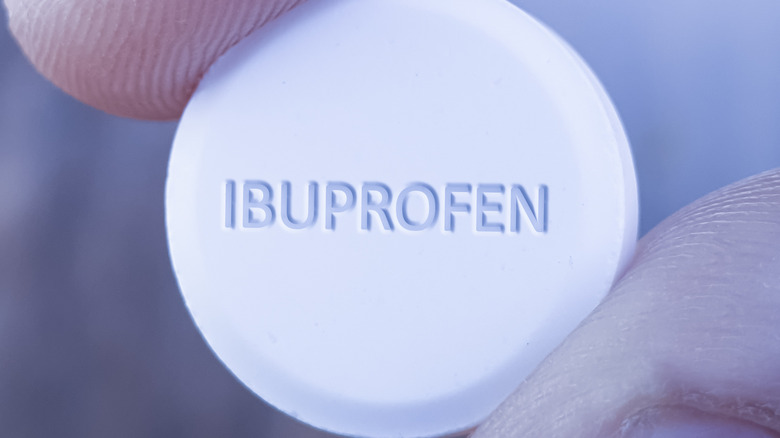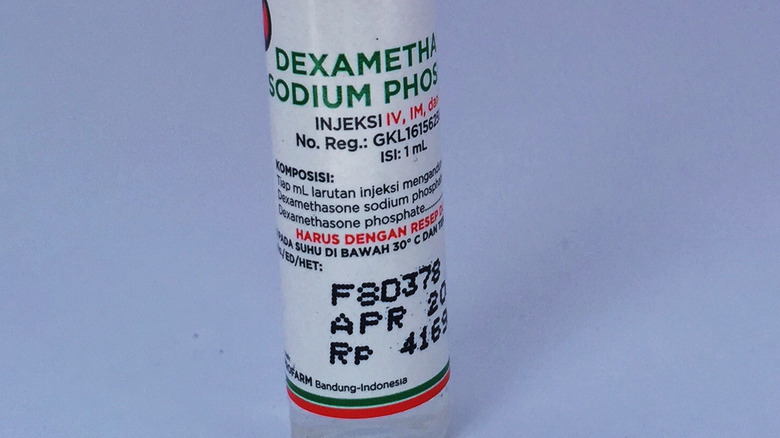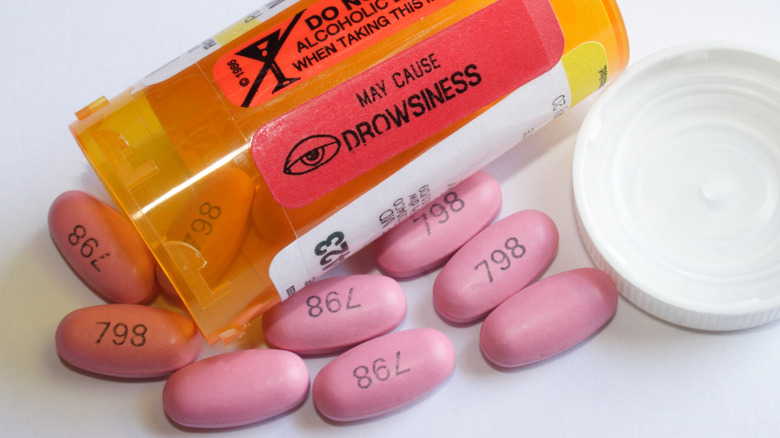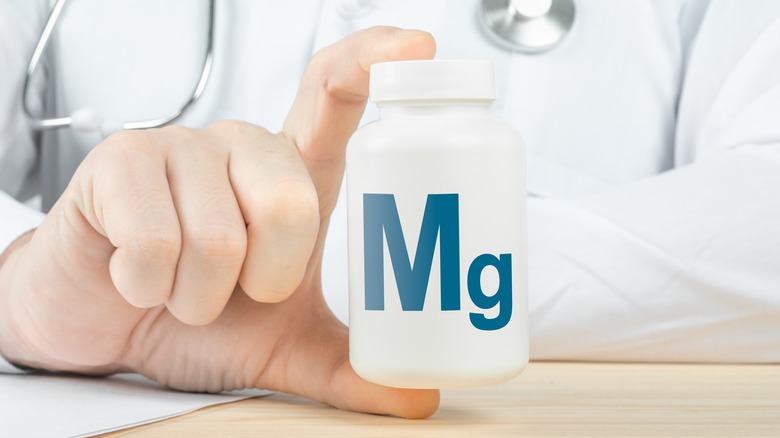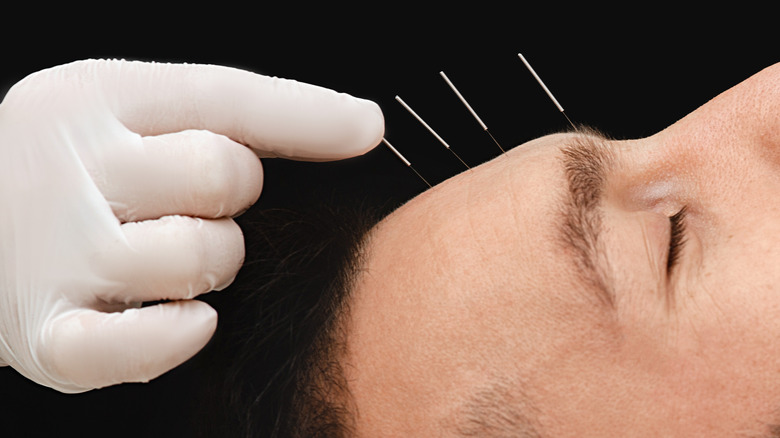What You Need To Know About Migraine Cocktails
It would be absurd to order a daiquiri when a migraine sets in, let alone step foot in a club or bar. That's because the severity of this debilitating headache may also be met with nausea and aversion to smell, as well as sensitivity to light and sound (via the American Migraine Foundation). But if symptoms are bad enough, a physician may prescribe a migraine cocktail — and no, it's neither alcoholic nor an antioxidant-rich beverage. A migraine cocktail is a combination of drugs to treat various symptoms that a migraine sufferer may face (via K Health). This type of cocktail is one treatment option (for acute attacks) that can be provided at the ER in an outpatient setting, or it may consist of a specific combination of over-the-counter (OTC) drugs at home.
While migraines don't affect everyone, they may be more prevalent than you may think. Migraines affect about a billion people worldwide – 1 in every 5 women (20%), 6.25% of men, and nearly 10% of children (via the American Migraine Foundation). In the United States, more than 39 million people are affected (via the American Migraine Foundation).
For some, avoiding common migraine triggers (e.g., stress, changes to one's routine, being hungry or thirsty) may not be enough, as there are personal triggers as well, per The Migraine Trust. These may be hard to identify amidst the ongoing combination of things we encounter daily. Hence, when a migraine strikes, a migraine cocktail may be one of your options.
What is a migraine cocktail?
A migraine cocktail is made-to-order, so to speak. While it's no pool-side piña colada, it's a carefully crafted mixture designed to provide effective relief. And for the severe migraine sufferer, there's nothing as sweet as symptom relief.
A doctor can customize each migraine cocktail based on a patient's current health conditions and history of medications that have brought the patient migraine relief (via The Greatest). Combinations may vary, though most migraine cocktails contain non-steroidal anti-inflammatories (NSAIDS), according to the American Migraine Foundation. In addition to NSAIDS, the most common ingredients include seizure meds, pain killers, antiemetics (for nausea relief), magnesium, and IV fluids for hydration (per The Greatest). Whatever the combo, it typically takes about an hour for the effects of the medications to kick in.
In a hospital, migraine cocktails are administered through an IV (via the American Migraine Foundation). Patients may receive multiple treatments or a continuous drip over the course of several days.
When would someone receive a migraine cocktail?
"This too, it shall pass" may be the mantra for migraine sufferers at home — often self-isolated and lying still in a sound-less, dark room until their medication has set in (and the symptoms have resolved enough to start functioning again). But when a severe migraine isn't responding to OTC meds, or the anguish has gone beyond 72 hours (i.e., status migrainosus), that's when a migraine cocktail may be necessitated, says Dr. Jennifer Robblee, a neurologist and an assistant professor in the Department of Neurology at Barrow Neurological Institute in Phoenix, Arizona for the American Migraine Foundation.
When a migraine becomes severe with unusual symptoms (such as confusion, fever, visual disturbances, and numbness or weakness), a trip to the ER is a must, according to the American Migraine Foundation. A migraine with an aura may prompt immediate medical attention, as it may increase risk for a future stroke (via Healthline). Stronger treatments can be provided via medical experts in such a hospital setting (via the American Migraine Foundation). This may be a double-edged sword, though — a trip to the ER may exacerbate symptoms, as it often bright, loud, and cacophonic.
Migraine cocktail in the ER
In the emergency room, a migraine cocktail will be administered through an IV (intravenous) line, either one medication at a time or all at once. That said, research suggests that simultaneous delivery may have better results (via Medical News Today).
However, it can take some time before a migraine cocktail is delivered, delaying a patient's relief. ER doctors will likely provide testing first, such as CT scans or spinal taps, as they approach neurological issues with caution (via the American Migraine Foundation). Furthermore, they typically aren't equipped with a patient's medical history; thus, they don't know which medications work best for the patient. As neurologists are better equipped to handle brain conditions such as migraines, they can help a patient help put together a rescue and treatment plan devised before the next attack and potential ER visit. This will include past treatments that have worked in mitigating the patient's severe migraine.
Migraine cocktail at home
You can prepare your own migraine cocktail with a combination of over the counter (OTC) medications. This consists of 250 milligrams of acetaminophen, 250 milligrams of aspirin, and 65 milligrams of caffeine — a safe and effective treatment, according to the FDA and the American Headache Society (via K Health). Some alternatives to acetaminophen (Tylenol) include ibuprofen (Advil) or naproxen (Aleve), via Healthline.
How does this combination work to alleviate a migraine? The acetaminophen and aspirin reduce inflammation and alleviate pain (via Medical News Today). The caffeine helps constrict blood flow which also helps reduce pain. Although it may be unlikely for someone to reach for a cup of coffee in the middle of a migraine, caffeine is an ingredient in some OTC pain relievers. Excedrin Migraine and Excedrin Extra Strength contain the migraine cocktail of acetaminophen, aspirin, and caffeine (via Healthline).
Be sure to read the labels for both active and additional ingredients. It may also be worth considering that caffeine may cause your heart to race and keep you restless at night. Plus, while caffeine can help provide migraine relief, it is also known to be a headache trigger, leaving its usage questionable (according to a 2020 review in Nutrients). Hence, skipping caffeine may be recommended if you are concerned about the side effects of the stimulant.
Triptans
Triptans are FDA-approved, and are considered to be among the most effective single treatments for moderate to severe migraine relief (via K Health).
One mechanism of action is thought to be through narrowing of the blood vessels in the brain to reduce the pain. Some types of triptans medications include almotriptan, eletriptan, frovatriptan, and naratriptan. They tend to be most effective when taken at the beginning of a migraine attack. They may also be a part of an intravenous migraine cocktail combination.
According to a 2014 review in Canadian Family Physicians, triptans work as serotonin agonists. The brain uses serotonin to perpetuate chronic pain at the nerve sites. Serotonin agonists prevent its activation by blocking its receptors, thereby mitigating unrelenting pain (via Johns Hopkins Medicine). Commonly used for migraines in outpatient settings, they can be administered in various ways, including nasal, pill form, or via injection (via Canadian Family Physicians). Common side effects include dizziness, injection site rash, and "pins and needles" sensations.
Antiemetics
Since both nausea and vomiting are characteristic of moderate to severe migraines, antiemetics may be included in the course of treatment, according to a 2014 review in Canadian Family Physician. They are effective in providing nausea relief, and come highly recommended for acute migraines in the ER. They work by blocking those receptors in the gut that trigger the nausea in the brain (via Osmosis from Elsevier). Additionally, they reduce the stimulation of the abdominal muscles and the diaphragm to suppress vomiting, a means to prevent severe dehydration. And like many of the migraine meds, antiemetics can be provided intravenously.
Antiemetics are generally tolerated; however, like any drug, there may be side effects. These include diarrhea or constipation, fatigue, dizziness, dry mouth, photosensitivity, and lightheadedness. Diphenhydramine (aka Benadryl) may be included with antiemetics, to reduce the risk of distress and agitation which is another side effect of the medication (via Canadian Family Physician).
Ergot alkaloids
One of several medications that may be used in a migraine cocktail, ergot alkaloids are used to block the pain (via Healthline). They work as antagonists to hormones that may proliferate the pain (via a 2007 review in Veterinary Toxicology). But because the antagonistic mechanism triggers vasoconstriction, they are not recommended for patients with hypertension or cardiac disease. It should be noted that vasoconstriction is not always helpful, as it may either help reduce headache and migraine pain or exacerbate it (via Healthline).
Side effects of ergot alkaloids include nausea and vomiting, tingling, hypertension, rapid heartbeat, lightheadedness, muscle cramps, and itching, according to a 2018 publication by the National Institute of Diabetes and Digestive and Kidney Diseases. These side effects are not clearly associated with acute liver injury, per research. However, for patients with underlying vascular disease, angina-like symptoms have been known to occur post intravenous injection, according to a 2012 review in Experimental and Clinical Cardiology.
NSAIDs
NSAIDs, or nonsteroidal anti-inflammatory drugs, are pain relievers that also help lower fevers and reduce inflammation, as their name implies (via Ortho Info). While they may be preventative against heart disease, their blood thinning action may also lead to bruising. They also increase stomach upset and nausea, because one mechanism of action prevents the enzyme COX1 from doing its job of lining the stomach. NSAIDS also block COX2 enzymes, inhibiting the body's inflammatory response to injury. Common over-the-counter NSAIDS include aspirin, ibuprofen, and naproxen.
An NSAID may be highly effective for acute migraine relief, according to a 2014 review in Canadian Family Physician. Its parenteral formulation (via injection or IV) is known as ketorolac, which may be administered through IV in the dosages of 30 milligrams every 6 hours. Whether or not there is added benefit when an NSAID is included in a migraine cocktail remains unclear. However, its usage alone has good efficacy.
IV steroids
Steroids are used to ease pain and inflammation (via Healthline). They may be used to prevent a migraine from returning within days post discharge. While current standards of steroidal use for migraine abortive therapy include a 10-milligram IV of dexamethasone (a corticosteroid) along with a 10-milligram IV of metoclopramide (an antiemetic), up to 2/3 of discharged migraine patients have returned to the ER within 48 to 72 hours (via Em Docs).
In a 2019 study in Annals of Emergency Medicine, a randomized trial of 220 individuals compared intravenous administration of 10 milligrams of dexamethasone to an IV single 160-milligram dose of long-acting corticosteroid for preventing migraine headache recurrence (each group received 10 milligrams of metoclopramide in addition to the steroid). Both the dexamethasone and the long-acting steroid group had a migraine recurrence 3 days status post treatment, with only 9% and 5% respectively without headache one week post discharge. The takeaway: While there is no long-term migraine relief guarantee, the commonly prescribed 10 milligrams of dexamethasone with 10 milligrams metoclopramide is effective for acute migraine relief.
IV fluids
Dehydration is a common trigger for migraines (via K Health). Furthermore, migraine symptoms like nausea and vomiting can exacerbate dehydration. Hence, IV fluids may be included in a patient's treatment plan.
Crystalloid solutions are the most common type of IV fluids (via the Cleveland Clinic). They contain small, dissolvable molecules that make it through the bloodstream into the cells and tissues quite easily. They generally contain saline (a salt and water solution) and a dextrose (sugar) in water called D5W. When dehydration is severe, the crystalloid solution may consist of sodium, chloride, potassium, calcium, and lactate for aggressive repletion.
While dehydration exacerbates pain, IV fluids alone may not be enough to curtail a migraine, according to Journal Feed. However, its usage may be warranted to decrease the symptoms of dehydration (including constipation, weakness, and dizziness) and prevent potential complications such as low blood volume and seizures (via Journal Feed and Medical News Today).
Valproic acid
Though commonly used to treat bipolar disorder and epilepsy, valproic acid may also be helpful in the prophylaxis of a migraine (via NHS). Adults 18 and over may be prescribed valproic acid tablet or caplets — a dosage of 500-1,000 milligrams per day (split into 2 to 3 doses) — to prevent recurrence of a migraine. A continuous intravenous feed of the drug may provide rapid, safe, and effective relief for pediatric migraines, according to a 2014 study in Neurology. Its intravenous form is called valproate sodium (via Headache – The Journal of Head and Face Pain). In severe migraine cases, it may be included in an IV migraine cocktail (via K Health). This medication may be an effective replacement for addictive pain relievers such as opiates (via Headache).
But for those with liver disease, mitochondrial disorders, or those who are pregnant, valproic acid and its intravenous form are contraindicated (via PDR). Pancreatitis has been a reported side effect; thus, symptoms of nausea, vomiting, and pain should be promptly evaluated with the usage of this medication.
Magnesium
According to a 2016 review in Pain Physician, magnesium deficiencies have been associated with migraines. Evaluating several randomized controlled trials, the review concluded that intravenous magnesium may reduce the severity of an acute migraine within 15-45 minutes, 2 hours, and 24 hours post infusion. More recently, a 2021 study in Acta Neurologica Belgica found that magnesium oxide (the pill form) was just as effective as valproate sodium in the prevention of a migraine. It provided no adverse effects.
The efficacy of magnesium in the treatment of migraines lies in its ability to block the signaling of visual disturbances such as a migraine aura (via the American Migraine Foundation). It may also block chemicals that transmit pain. Magnesium oxide is an oral form of the natural element (and is also known as "milk of magnesia"), according to RO Health Guide. The magnesium oxide pill is dosed at 400-600 milligrams per day (via the American Migraine Foundation). Magnesium sulfate (1-2 milligrams) is the form that hospitals use to administer through an IV.
Migraine cocktail side effects
While migraine cocktails are typically well tolerated, some people may experience side effects (via Medical News Today). Allergic reactions are rare, but possible. Mild headaches and dizziness may present from the NSAID ketorolac and antiemetics. Both acetaminophen the dexamethasone (a steroid) may trigger or exacerbate a headache. Electrolyte imbalances may occur from magnesium and the dexamethasone. Acetaminophen may also cause nausea and potential vomiting. Ketorolac usage may lead to ringing in the ears (tinnitus). Potential side effects of an OTC migraine cocktail include abdominal pain, diarrhea, and trouble sleeping (via Healthline). Frequent dosages of any of the medications in any type of migraine cocktail may cause more severe reactions or toxicity. Ironically, the risk for medication overuse is a headache.
Talk to your doctor before receiving a migraine cocktail or making your own OTC migraine cocktail (via Healthline). It is important to let your physician know if you are pregnant or breastfeeding, have asthma, have liver, kidney, or heart disease, have a history of heartburn or ulcers, or are taking other medications such as diuretics, blood thinners, steroids, or other NSAIDs.
Alternative treatments
Migraine cocktails may vary, and so may the medical treatment (via the American Migraine Foundation). The medication combo is dependent on a person's migraine symptoms and how well they've responded to past medications for relief. But it may very well be that a migraine cocktail is not necessarily what a patient needs.
In some cases, a patient may respond to well to oral triptans and/or anti-seizure medications. Alternative medical applications for aborting a migraine include nerve blocks or trigger point injections, procedures that can stop head pain by shutting down overactive pain signals. Both nerve blocks and trigger point injections use a local anesthetic with or without an anti-inflammatory steroid medication (via Medical News Today and MedStar Health).
For those looking to try a non-medicine approach, behavioral therapy may also be helpful. This includes relaxation techniques such as mindfulness and biofeedback to ease the distress of a migraine and calm the brain and body. Non-medical alternatives to managing migraines include hot/cold treatments to the face, head, or neck, retreating to a dark and quiet space, massage therapy, and acupuncture (via WebMD).


